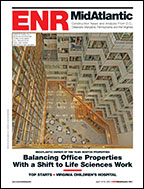 |
| KICKOFF Testing is under way at I-90 vent building (left) at Fort Point Channel. |
There's a cold wind blowing through downtown Boston and that is warming the hearts of Central Artery/Tunnel managers. As final tests wind up on the tunnel ventilation system, the CA/T is set to open on Jan. 20 a $6.5-billion, 3.5-mile section linking Logan International Airport to Interstate 90.
The I-90 portion eliminates a major traffic choke hold and alleviates congestion in two existing tunnels. The road also has spurred at least $1 billion in new development in the Seaport District, which it bisects. "I-90 is a model of urban construction for the rest of the country to follow," says Matthew J. Amorello, chairman of the Massachusetts Turnpike Authority, which oversees CA/T. "While costly, it has enhanced the quality of life by greatly reducing travel time through the city and by opening the Seaport District and areas west of the city to new economic development."
 |
| FINISHING TOUCHES Work is about done at western I-90 entrance. |
Construction of the I-90 section began in 1991 with the Ted Williams Tunnel, which opened in 1995. Subsequent work consists of a monumental array of jacked, immersed concrete tubes and cut-and-cover tunnels that, among other things, channel through a 750,000-cu-yd deep-soil and ground-freezing stabilization operation. The tunnels link four major interchanges, including the I-93 section still under construction, and burrow beneath a rail yard and the Ft. Point Channel.
"The variety of techniques used to complete the I-90 extension includes the largest volume of jacked tunnels ever undertaken in the world, combined with the largest soil-mix operation in North America and the first use of concrete immersed tube tunnels in the U.S., all in a very congested urban setting," says Michael P. Lewis, CA/T project director. "We were a proving ground for these techniques and owners and engineers from around the world have visited our site to learn from our experiences."
In all, about 30 prime contracts were let. "We won one of the first artery contracts back in 1990, a $10-million haul road," says John H. Pastore, president of Cambridge, Mass.--based Modern Continental Construction Co. Inc. "Since then, we've done over $900 million on I-90 alone, including the immersed tubes."
"We jacked three tunnels totaling about 800-ft-long by 80-ft-wide and 38-ft- high under active rail," notes Michael A. Waters, project manager for Slattery/Interbeton/White/Perini JV, Boston. "It was a huge technological success and raised the level of expertise for all four companies" in the joint venture.
Originally scheduled to open in December 2001, the section could have been three years late. Soil-mixing operations at Ft. Point Channel hit major obstructions and sedimentation problems, causing an estimated 24-month delay. A leaking seal flooded portions of the immersed tubes for a six-month delay and software problems in the Intelligent Transportation System added another two-month delay. Combined with late starts, managers were looking at an opening late next year.
 |
| BERTOULIN |
To overcome that "we went with simultaneous dredging, drilled-shaft installation and soil stabilization activities, which recovered about six months," says Michael T. Bertoulin, CA/T I-90 milestone manager. "In addition, we modified our plan to store an additional immersed tube, getting four tubes out of the casting basin and expediting construction of the final two, which saved another six months. We also modified a landside tunnel joint to save another six months and created plugs on both sides of the channel to support earlier cut-and-cover sections. In essence, we compressed two years of construction into 12 months."
Workers now are applying finishing touches as operators in two tunnel vent buildings finish tests on the exhaust systems. "This is a state-of-the-art tunnel built to safely handle up to 80,000 vehicles daily over a 75-year design life,"says Bertoulin.


Post a comment to this article
Report Abusive Comment